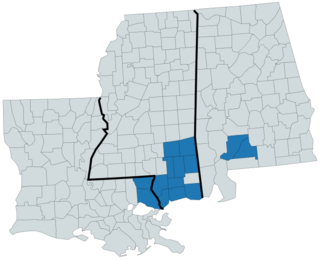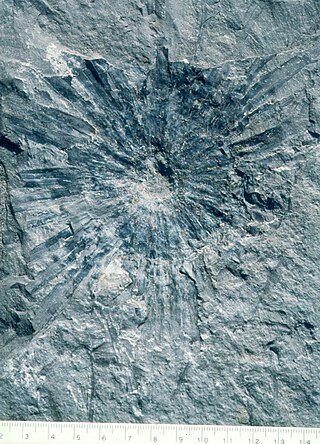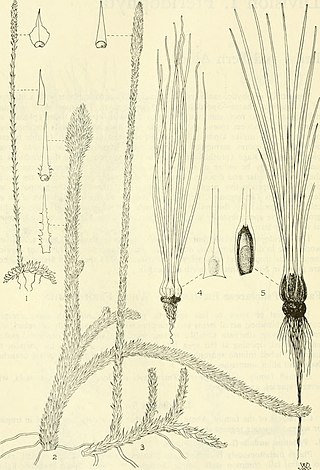
Isoetes, commonly known as the quillworts, is a genus of lycopod. It is the only living genus in the family Isoetaceae and order Isoetales. There are currently 192 recognized species, with a cosmopolitan distribution mostly in aquatic habitats but with the individual species often scarce to rare. Species virtually identical to modern quillworts have existed since the Jurassic epoch, though the timing of the origin of modern Isoetes is subject to considerable uncertainty.

Isoetes louisianensis, the Louisiana quillwort, is a small, grass-like aquatic plant of the family Isoetaceae. It is "one of the rarest quillworts in North America." It occurs in only five locations in St. Tammany and Washington Parishes of Louisiana, as well as some spots in southern Mississippi and south-central Alabama. It is federally listed as an endangered species, partly due to its highly restricted range.

Isoetes lacustris, the lake quillwort or Merlin's grass, is a boreal quillwort native on both sides of the northern Atlantic Ocean. Synonyms include Isoetes hieroglyphica.

Isoetales, sometimes also written Isoëtales, is an order of plants in the class Lycopodiopsida.
NVC community H7 is one of the heath communities in the British National Vegetation Classification system. It is one of two communities categorised as maritime heaths.

Lobelia dortmanna, Dortmann's cardinalflower or water lobelia, is a species of flowering plant in the bellflower family Campanulaceae. This stoloniferous herbaceous perennial aquatic plant with basal leaf-rosettes and flower stalks grows to 0.7–2 m (2.3–6.6 ft) tall. The flowers are 1–2 cm long, with a five-lobed white to pale pink or pale blue corolla, produced in groups of one to ten on an erect raceme held above the water surface. The fruit is a capsule 5–10 mm long and 3–5 mm wide, containing numerous small seeds.

Isoetes taiwanensis is a species of plant in the family Isoetaceae. It is endemic to Taiwan, and the only species of quillwort there. Isoetes taiwanensis can now only be found in Menghuan Pond in Yangmingshan National Park.

Isoetes engelmannii is a species of aquatic plant in the family Isoetaceae. It is referred to by the common names Engelmann's quillwort or Appalachian quillwort, and is the most widely distributed species of its genus in eastern North America. Its range extends from Ontario in the north, south to Florida and west Arkansas and Missouri. It can be found from April to October in temporary pools, bogs, marshes, stream edges, swamps and along wet roadsides.

Isoetes tegetiformans, commonly known as mat-forming quillwort or mat-forming Merlin's grass, is an aquatic lycophyte endemic to the U.S. state of Georgia. It grows exclusively in shallow, temporary pools on granite outcrops, often with only 2 cm of soil. Only 7 populations are known to exist, and three of these have been destroyed since the plant's discovery in 1976. The remaining populations are threatened with habitat destruction due to quarrying, though the species is protected under the U.S. Endangered Species Act. New leaves quickly sprout after fall and winter rains, but during the dry summer months these typically shrivel.

Isoetes melanospora, commonly known as black-spored quillwort or black-spored Merlin's grass, is a rare and endangered aquatic lycophyte endemic to the U.S. states of Georgia and South Carolina.
Isoetes nuttallii, or Nuttall's quillwort, is a species of quillwort, a type of lycopod. It is native to shallow waters and other wet habitats of western North America from British Columbia to California. It produces up to 60 pointed, cylindrical, green to gray-green leaves, each 7 to 17 centimeters long. The velum completely covers the spherical sporangia, which are 5 millimeters long and 1.5 millimeters wide. The ligule is small and triangular. The megaspores are 400 to 500 micrometers in diameter. The microspores, which are spiny and covered in tubercles, are 28 to 31 micrometers long.
Isoetes eludens is an aquatic plant in the genus commonly known as quillwort that is native to the Kamiesberg Mountains in Namaqualand, South Africa. So far it is known to grow only in a single !gau (gnamma), a small temporary pool formed in a hollowed out area of granite rock. It has likely been growing in that region for millions of years, but was only discovered in 2007 and described in 2009. The specific epithet eludens refers to the fact that it eluded discovery, in spite of several searches in recent years in the area for new quillwort species.

Isoetes echinospora, also known as spiny quillwort, spiny-spored quillwort or spring quillwort is a species of quillwort in the Isoetaceae family, and is the most abundant species in Canada. It can be found in shallow aquatic environments from Labrador and Newfoundland to Alaska, and south to Pennsylvania, Wisconsin, Michigan, Colorado, and California. In Germany it is found in only two locations: the Feldsee and Lake Titisee, both in the High Black Forest.
Isoetes × eatonii, or Eaton's quillwort, is a hybrid between I. engelmannii and I. tenella. It can be found in ponds and slow moving rivers in Canada or in several New England states. In Canada, it has only been found in the Severn River in Ontario. In the United States, it has been found in Pennsylvania, New Jersey, and New York. It bears 12-100 long yellowish green leaves, each fine, soft, and 8 to 45 centimeters long. The unspotted tan colored sporangium are 12 millimeters long and 5 millimeters wide. The velum covers a sixth to a quarter of the sporangium. The elongated ligule is 3.5 millimeters long. The flattened white megaspores are 320 to 530 micrometers in diameter and bear short spiny ridges. The round microspores are 22 to 25 micrometers long.

Isoetes riparia, the shore quillwort, is a species of plant in the family Isoetaceae. It can be found in rivers, creeks, and tidal mud flats in southern Quebec and southeastern Ontario, south to eastern New York. It has 5 to 35 long, erect bright green to yellow-green leaves, which are 6 to 35 centimeters long. The velum covers one fourth of the sporangium, which can be 7 millimeters long and 4 millimeters wide. The elongated ligule can grow to be 3 millimeters long. The spherical megaspores are 430 to 680 micrometers in diameter with closely set ridges. The kidney-shaped microspores are 24-35 micrometers long, and usually have spine-tipped tubercules. The megaspores can sometimes come to resemble that of either I. echinospora, if the megaspores become eroded and bear projections that could resemble spines, or I. macrospora, if the broken ridges take a certain shape.
Isoetes acadiensis, the Acadian quillwort is a species of quillwort in the Isoetaceae family described by Kott in 1981. It can be found along the shores of lakes, ponds, and rivers in Newfoundland, Nova Scotia, and New Brunswick, as well as in the American states Maine, Massachusetts, and New Hampshire. It has a similar distribution to that of I. tuckermanii. It bears 9 to 35 mostly recurved leaves, each 5–21 cm long. The leaves are usually dark green, though can occasionally be tinged with red. The sporangium can be up to five millimeters long and 3 millimeters in length, covered one sixth to one third by the velum. The spherical megaspores are 400-570 micrometers in diameter, and bear smooth ridges. The kidney shaped microspores are 25 to 30 micrometers long. It was originally believed to be a member of Isoetes hieroglyphica because of their similar megaspore structure.

Isoetes beestonii is a species of isoetalan plant from the latest Permian of New South Wales and Queensland. Originally considered earliest Triassic, it is now known to be latest Permian in age, immediately before the Permian Triassic mass extinction. It has been suggested to be the earliest member of the genus Isoetes, which contains living quillworts, though it differs from living Isoetes in some aspects, with modern forms of Isoetes possibly emerging during the Jurassic.

Isoetes butleri, commonly known as limestone quillwort, is a species of plant in the quillwort family, a member of the lycophytes.

Isoetes melanopoda is a species of nonflowering vascular plant belonging to the quillworts in the family Isoetaceae. Its common names include: black-footed quillwort, midland quillwort, and prairie quillwort.












